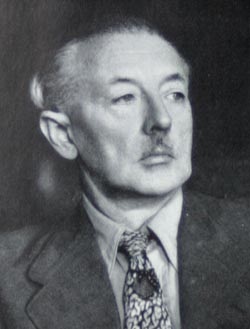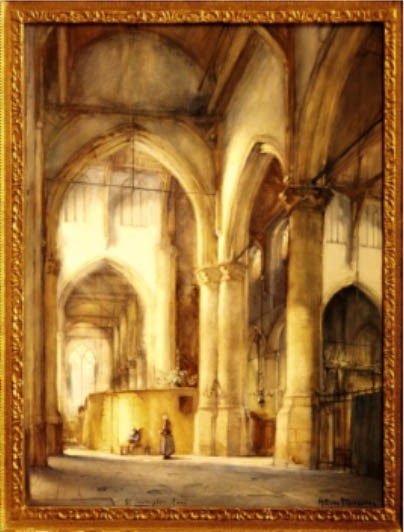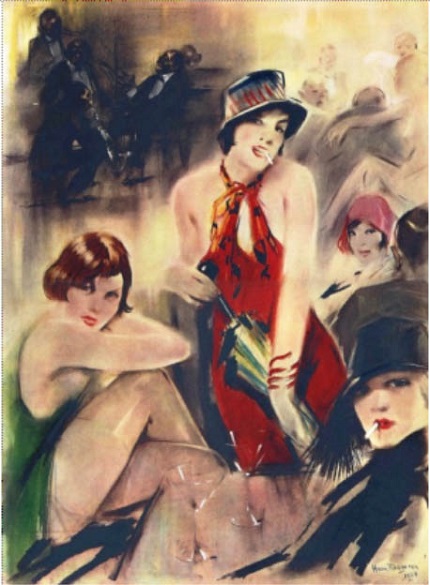
| Print | Back |  |
September 16, 2013 |
 |
Moments in Art The Fabulous Faker's False Fable, Part Oneby Lawrence Jeppson |
For decades the tale of how and why Han van Meegeren began painting bogus paintings was as fraudulent as the bogus works of art that made him the most famous forger of the 20th Century.
Here, in a nutshell, is the beginning of his easel fakery as I reported it in my 1970 book The Fabulous Frauds, Fascinating Tales of Great Art Forgeries. My account was more thorough than anything that had been published, and part of it was picked up and published as authoritative in the Dutch press. Turns out, decades later, that I had swallowed Van Meegeren’s tale as he had confessed it to newspapers and the court. The truth was much more nefarious.
Van Meegeren (1889-1947) declared in court that his most famous forgery, The Supper at Emmaus, was his first forgery. For years the world believed him. For a brief period he gloried as a Dutch folk hero. He was a prodigious liar.

Van Meegeren was an artist trapped in the 17th Century. (No falsehood there.) By the age of ten, drawing was an obsession, as was playing practical jokes, some of which got him into trouble. At 12, he locked the door to the local constabulary and threw the heavy key, which also served as the doorknob, into a nearby canal, keeping the inside policemen from getting out and the outside police from getting in.
His rigid schoolmaster father wanted him to become an architect. In the same year he locked up the policemen, Han began taking art lessons from Bartus Korteling (1853-1930), who trained him rigorously in the artistic methods, observations, and meticulous brushwork of earlier golden-age Dutch painters. Han lived all his spare moments reading, studying, painting, and trying to match the work of early masters.
Han’s regimenting father, still thinking architecture, said he would pay for the boy’s six years of university schooling if he could finish it in five. So Han went off to school in Delft, where Vermeer had painted. Free from paternal oversight, he studied hard, lived hard, and painted hard. The balance he struck allowed little time for architecture.
In 1911, he met Anna de Voogt, daughter of a Catholic Dutchman and a Muslim woman from Sumatra. She insisted he was wasting his time in architecture and should concentrate on his art. She was pregnant when they married the next year. He flunked his Delft exams but won a gold medal and $300 for a watercolor of the interior of a classic Rotterdam church.

He accepted his father’s conditional offer to pay for the sixth year at the university, but when Han got to the finals he realized that if he passed he would be an architect forever. He quit.
He petitioned The Hague Academy of Art to give him its diploma in art. He passed the written portions of the test but failed in an exam for portraiture. He then had to paint a still life. While he painted this he noticed that the judges were ranged across the background. He added a portrait of each as the background to the still life. It was a tour de force, and they gave him his diploma.
He got his degree in 1914, on the day Britain went to war with Germany. He and Anna suffered terrible years again. He sold very little and spent far more than he earned. They continued to be helped by her grandmother.
He ran into Korteling, who became the Van Meegerens’ houseguest. He and Han huddled like two alchemists, grinding and brewing ingredients to duplicate the paints of the ancients.
Trying to sweeten a marriage that was going sour, Anne invited all her rich relatives to a show of Han’s art. Everything sold: a momentary success. At the show he met Johanna van Walraven, actress wife of Karel de Boer, an art critic who came to interview him. Han and Jo began living together long before Anna divorced him in 1923.
At another show, a critic offered to give Han a raving review in exchange for a substantial bribe. Van Meegeren refused. There was no review. Han began to see venality on every side. When an American dealer offered him a one-year contract of $15,000 and all expenses if Han would paint a portrait a week, the task seemed too onerous, and Han said no. He was already making more money as a forger.

To expose the rottenness of the Dutch art community, Han and his best friend, Theo Wijngaarden, and a writer name Jan Ubink decided to produce a monthly periodical De Kemphaan/The Fighting Cock, which, angry, sarcastic, and libelous, attacked critics, art historians, Surrealism, bribery, and the incompetence of experts. Although Hitler had not come to power, Van Meegeren was a sympathizer and shared many Fascist views.
Theo Wijngaarden claimed that he had mistakenly cleaned a genuine Vermeer using alcohol, which will not remove original, hardened paint from old paintings but will remove newer paint. Theo had cleaned the painting with alcohol and then retouched it. The retouching failed the alcohol test, and the painting was branded a fake. Then Theo presented another Vermeer to Dr. Abraham Bredius, the most illustrious art historian in Holland. When Bredius declared it genuine, Theo slashed it into pieces, declaring it was a genuine Wijngaarden!
Han van Meegeren got the idea of tricking the scholar by painting a fake Vermeer that would be so good Bredius would be forced to authenticate it.
This is where Han van Meegeren, who viewed himself as a misunderstood genius, wanted the world to believe that his life as a forger started. That and lots of other things he and Wijngaarden said were blatant lies.
In 2008, two exhaustibly researched books were published that reveal Van Meegeren’s deep involvement in the rotten stratum of the Dutch art community. One of these, written by Jonathan Lopez, was The Man Who Made Vermeer, “Unvarnishing the Legend of Master Forger Han van Meegeren.” Lopez spent three years searching archives in Holland, the United States, Great Britain, and Germany and interviewing descendants of Van Meegeren’s cabal:
I learned that Van Meegeren worked for decades with a ring of shady art dealers promoting fake old masters, some of which ended up in the possession of such prominent collectors as Andrew Mellow and Baron Heinrich Thyssen. All the while, Van Meegeren cultivated a fascination with Hitler and Naziism that, when the Occupation came, would provide him entree to the highest level of Dutch collaborators. (Lopez, p.2).
The other was written by Edward Dolnick, The Forger’s Spell, “A True Story of Vermeer, Nazis, and the Greatest Art Hoax of the Twentieth Century.” Dolnick’s approach is different but also is thoroughly researched. In his preface he succinctly presents Van Meegeren’s dilemma:
Where there was no crime, it stood to reason there was no criminal. For a villain who craved recognition, that made for a vicious dilemma. Keep his crime secret, and he would live rich and safe but unknown. Confess what he had done, on the other hand, and though he would find himself condemned to a prison cell, his genius would be proclaimed worldwide.
In both books the authors explode the details and extent of Han’s duplicity. He was a crook from the start.
Giving up a job teaching drawing at Delft, Han moved to The Hague, Holland’s fun-infested, wealthy capital. By making charcoal sketches of important people at a variety of public and private events, Han infiltrated the moneyed class and became in demand as a portrait painter.
Theo Wijngaarden was a The Hague art restorer who was part of a cabal that included several questionable individuals, including art dealer Leo Nardus, who in 14 years sold American collector P. A. B. Widener 93 paintings, including three Vermeers. Suspicions aroused, Widener summoned three international experts to his 110-room Philadelphia mansion — Englishman Roger Fry, German Wilhelm Valentiner, and American Bernard Berenson. They denounced most of the collection.
Art fraud includes adding artists’ names to questionable paintings, repainting or restoring old paintings so that they can be attributed to more important artists, and painting complete fakes. Nardus’s paintings included examples from all three classifications. As a restorer, Theo Wijngaarden was skilled in the first two, but was not sufficiently skilled to paint a really good fake that required portraiture.
Van Meegeren had to support Ann and the two children (they moved to Paris) and Jo and her child. He led a life of licentiousness, drinking, and carousing. His expenses stretched far beyond what he was making in portraiture. A hookup with Theo Wijngaarden was a natural, and, according to Lopez’s research, they began working together before 1921.
Neither man sold directly to the ultimate buyers. Instead they used a variety of finders, runners, other intermediaries, and dealers so that newly discovered paintings could not be traced back to them. In June, 1927, one of these runners, Harold B. Wright, an Englishman with dreams of wealth, showed up Kaiser Frederick Museum. He was carrying an unknown painting, The Lace Maker, by Johannes Vermeer (1632-1675) that he had discovered in an Amsterdam antique shop.
He sought authentication of the painting from the museum’s director Dr. Wilhelm von Bode, a respected authority. After close consideration, Bode wrote a certificate declaring the painting to be a “genuine, perfect, and very characteristic work of Jan Vermeer of Delft.” The painting was then exhibited in the museum.
Caught up in a Vermeer frenzy of the time, Sir Joseph Duveen, the most powerful art dealer in the world, bought two astonishing Vermeer oils, The Smiling Girl and The Lace Maker, and sold them to Andrew Mellon, a Pittsburgh banker.
When Mellon gave his art and his money to create the National Gallery in Washington, D.C. (in appreciation, many of us still referred to it occasionally as the Mellon Museum), these two Vermeers were a valuable part of it. They hung in the Dutch rooms until the 1950s.
Both were Han van Meegeren fakes.
| Copyright © 2025 by Lawrence Jeppson | Printed from NauvooTimes.com |